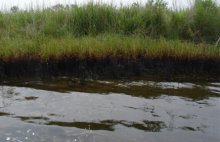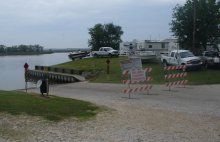Citgo Refinery - Calcasieu River
Oil Spill | Calcasieu River, LA | June 2006
What Happened?
On June 19, 2006, over 99,000 barrels of waste oil and millions of gallons of untreated oily wastewater overflowed from storage tanks and discharged into a containment area in CITGO’s Lake Charles Manufacturing Complex. An estimated 54,000 barrels of waste oil and an undetermined amount of oily wastewater flowed out of the containment area and into the Indian Marais, the Calcasieu River, and adjoining waterways in the Calcasieu Estuary.
What Were the Impacts?
Approximately 150 linear miles of shoreline habitats were affected by the spill, including hundreds of acres of marsh, intertidal, and subtidal sediments. The oil directly impacted fish, benthic organisms, and several species of birds, including secretive marsh birds such as rails and larger birds such as gulls.
The released oil was in a highly volatile and acutely toxic form, requiring initial closure of oiled areas to responders and natural resource damage assessment teams. The highly toxic compounds in the oil were soluble, resulting in significant mixing into the water column. Between June 23 and June 28, numerous fish kills were observed in and around the floating oil.
In the days following the spill, fishing and other recreational activities in the area were shut down.
What’s Happening Now?
On August 31, 2021, the U.S Department of Justice finalized a Consent Decree valued at $19.69 million to restore natural resources injured by the Citgo Refinery oil spill.
This Consent Decree settled claims of injuries and will go towards restoration projects that benefit habitats, fish, wildlife, and outdoor recreational activities impacted by the oil spill.
On February 24, 2022, the trustees released the Final Damage Assessment and Restoration Plan (PDF, 132 pages), with selected projects to restore the resources injured by the spill. The selected restoration projects include
-
Restoring 392 acres of saline marsh, including tidal creeks, in shallow open water in Cameron Parish, Louisiana,
-
Creating approximately 18 acres of oyster reef habitat in Cameron Parish, Louisiana and,
-
Contributing to an ongoing large project to create suitable nesting habitat for coastal island nesting birds in Terrebonne Bay, Terrebonne Parish, Louisiana
With the projects identified in this Final Restoration Plan, the trustees aim to restore approximately 432 acres of habitat near the Calcasieu estuary to compensate for injuries to shoreline habitats, oysters and birds
“The slop oil that was released during the spill was like nothing I have seen in years of assessing oil spill injuries in Louisiana. Implementing restoration projects that enhance the natural resources in the Calcasieu Estuary is a high priority for the trustees.”
Gina Muhs Saizan, Natural Resource Specialist, Louisiana Oil Spill Coordinator's Office
Contacts
Daniel Hahn, Ph.D.
NOAA Assessment & Restoration Division
St. Petersburg, FL
(727) 551-5715
Daniel.Hahn@noaa.gov








